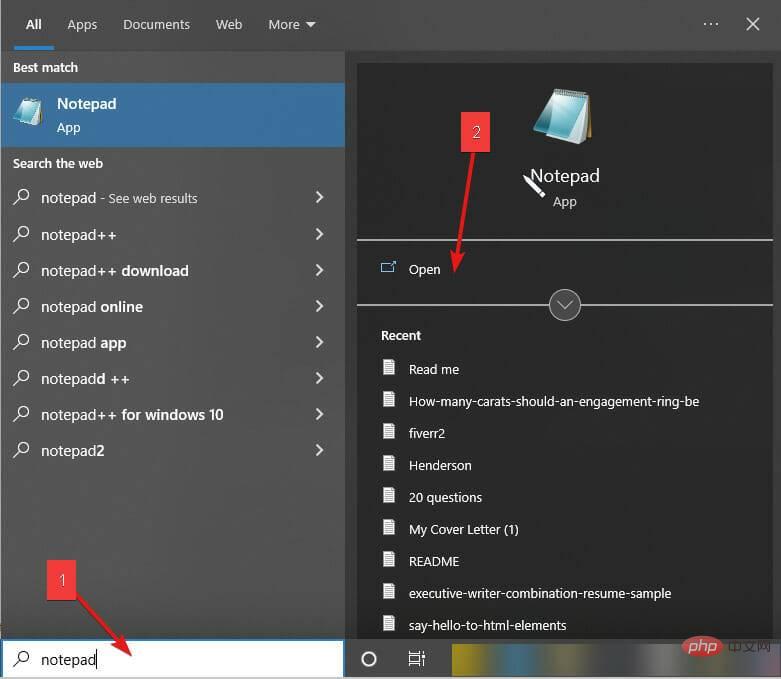As modern applications continue to grow and expand, cloud deployment has become the first choice for many enterprises and developers. In this area, AWS (Amazon Web Services) has become a popular choice. Laravel is a popular PHP framework that provides a simple and easy way to develop fast and reliable web applications. This article will discuss how to use Laravel Vapor to deploy applications to AWS, making your applications faster, more reliable, and more secure.
- Register an AWS account
To use AWS, you first need to register an AWS account. Registration is free, you just need to sign up to use it, but you will need to provide your credit card information.
- Install and configure the AWS CLI
The AWS CLI (Command Line Interface) is the easiest way to work with AWS. By using the CLI, you can easily complete tasks that require many clicks from the command line. Run the following command from the command line to install the AWS CLI:
curl "https://awscli.amazonaws.com/awscli-exe-linux-x86_64.zip" -o "awscliv2.zip" unzip awscliv2.zip sudo ./aws/install
After the installation is complete, you need to configure the CLI by running the following command:
aws configure
At this point, you will be asked to enter your AWS Access Key ID and Secret Access Key. You will also be asked to select a default region and default output format. After entering this information, your CLI is ready to connect to AWS.
- Create Laravel Application
If you already have a Laravel application, you can skip this step. Otherwise, you can use Laravel's own command line tools to create a new application. Run the following command:
composer create-project --prefer-dist laravel/laravel my-app
This will create a new Laravel project named my-app in the current directory and print a few lines of useful information after installation.
- Install Vapor CLI
Vapor is a server management tool provided by Laravel. It can be used to manage your Vapor environment and instances. To use Vapor, we need to install the Vapor CLI. It can be installed by running the following command in the command line:
composer global require laravel/vapor-cli
Once the installation is complete, you must ensure that your CLI is updated to use Vapor:
export PATH="$PATH:$HOME/.composer/vendor/bin"
- Create a Vapor plan and Environment
Before deploying the application to Vapor, we need to create a plan and environment in Vapor. A plan is a set of compute and storage specifications that define the resources of your Vapor instance. An environment is the environment in which your application runs, such as development, production, etc.
To create a plan, open https://vapor.laravel.com and click "Create Plan". In the pop-up window, enter the name of your plan and the specifications required for the plan. To create an environment, click Create Environment and enter the environment name. You can set many options on your plan and environment, such as number of instances, availability zones, and more.
- Deploy the application
After you set up your plan and environment, the Laravel Vapor CLI can deploy your application. To deploy your application, use the following command in the application directory:
vapor deploy
This will build your application using the settings in the Vapor configuration file and deploy it to the Vapor environment. During this process, the Vapor CLI will tell you what is happening, such as the application being built, files uploaded, instances released, etc.
After the deployment is completed, view the deployment details in the "Deployment" section of the Vapor console. You can see the status of the deployment and view the deployment log.
- Cleanup
If you no longer need the Vapor instances, you can delete them using the following set of commands:
vapor destroy <app-name>
This will stop the Vapor instances and delete them. This will not affect your instances in AWS, but it will delete the ones you registered with Vapor.
Conclusion
Now that you know how to use Laravel Vapor to deploy applications to AWS, the advantage of using Vapor is that it makes it easier to build, deploy, and maintain Laravel applications than traditional AWS services . Vapor provides many useful features such as automatic scaling, backup and archiving, etc. to make operating and maintaining your application easier. Learning to use it and practicing it will bring you more benefits.
The above is the detailed content of Laravel development: How to deploy application to AWS using Laravel Vapor?. For more information, please follow other related articles on the PHP Chinese website!
 一起来聊聊Laravel的生命周期Apr 25, 2022 pm 12:04 PM
一起来聊聊Laravel的生命周期Apr 25, 2022 pm 12:04 PM本篇文章给大家带来了关于laravel的相关知识,其中主要介绍了关于Laravel的生命周期相关问题,Laravel 的生命周期从public\index.php开始,从public\index.php结束,希望对大家有帮助。
 在Go语言中使用AWS:完整指南Jun 17, 2023 pm 09:51 PM
在Go语言中使用AWS:完整指南Jun 17, 2023 pm 09:51 PMGo(或称Golang)是一种现代化的高性能编程语言,在近年广受开发者欢迎。AWS(AmazonWebServices)则是业界领先的云计算服务提供商之一,为开发者提供了丰富的云计算产品和API接口。在本文中,我们将介绍如何在Go语言中使用AWS来构建高性能的云应用程序。本文将涵盖以下主题:安装AWSSDKforGo连接AWS存储数
 在Go语言中使用AWS CloudWatch:完整指南Jun 17, 2023 am 10:46 AM
在Go语言中使用AWS CloudWatch:完整指南Jun 17, 2023 am 10:46 AMAWSCloudWatch是一个监视、日志管理和指标收集服务,它能帮助您了解您的应用程序、系统和服务的性能和运行状况。作为AWS提供的一项功能齐全的服务,AWSCloudWatch能够帮助用户监控和管理AWS资源,以及应用程序和服务的可监视性。在Go语言中使用AWSCloudWatch,您可以轻松地监视您的应用程序,并在发现性能问题时立即解决问题。本文
 laravel中asset()方法怎么用Jun 02, 2022 pm 04:55 PM
laravel中asset()方法怎么用Jun 02, 2022 pm 04:55 PMlaravel中asset()方法的用法:1、用于引入静态文件,语法为“src="{{asset(‘需要引入的文件路径’)}}"”;2、用于给当前请求的scheme前端资源生成一个url,语法为“$url = asset('前端资源')”。
 实例详解laravel使用中间件记录用户请求日志Apr 26, 2022 am 11:53 AM
实例详解laravel使用中间件记录用户请求日志Apr 26, 2022 am 11:53 AM本篇文章给大家带来了关于laravel的相关知识,其中主要介绍了关于使用中间件记录用户请求日志的相关问题,包括了创建中间件、注册中间件、记录用户访问等等内容,下面一起来看一下,希望对大家有帮助。
 laravel中间件基础详解May 18, 2022 am 11:46 AM
laravel中间件基础详解May 18, 2022 am 11:46 AM本篇文章给大家带来了关于laravel的相关知识,其中主要介绍了关于中间件的相关问题,包括了什么是中间件、自定义中间件等等,中间件为过滤进入应用的 HTTP 请求提供了一套便利的机制,下面一起来看一下,希望对大家有帮助。
 laravel路由文件在哪个目录里Apr 28, 2022 pm 01:07 PM
laravel路由文件在哪个目录里Apr 28, 2022 pm 01:07 PMlaravel路由文件在“routes”目录里。Laravel中所有的路由文件定义在routes目录下,它里面的内容会自动被框架加载;该目录下默认有四个路由文件用于给不同的入口使用:web.php、api.php、console.php等。
 从浏览器上传大文件到 S3 时的最佳实践Apr 18, 2023 pm 07:10 PM
从浏览器上传大文件到 S3 时的最佳实践Apr 18, 2023 pm 07:10 PMAmazonS3对于组织或企业持续备份其工作数据至关重要。这个过程确保了良好的连续性和问责制。一个有效的想法是通过AmazonSimpleStorageSolution(AmazonS3)。这是一项出色的服务,它提供了用于保存系统数据的海量远程存储服务。本文向您介绍了以尽可能最远程的方式将大文件从浏览器上传到S3的最佳实践。这些做法跨越了文件到S3的优化;如何上传大于100兆字节的文件,以及以最大速度上传文件,所有这些都通过使用AmazonS3。但是,如果您遵循此处规定的规则


Hot AI Tools

Undresser.AI Undress
AI-powered app for creating realistic nude photos

AI Clothes Remover
Online AI tool for removing clothes from photos.

Undress AI Tool
Undress images for free

Clothoff.io
AI clothes remover

AI Hentai Generator
Generate AI Hentai for free.

Hot Article

Hot Tools

SublimeText3 Mac version
God-level code editing software (SublimeText3)

SAP NetWeaver Server Adapter for Eclipse
Integrate Eclipse with SAP NetWeaver application server.

Atom editor mac version download
The most popular open source editor

mPDF
mPDF is a PHP library that can generate PDF files from UTF-8 encoded HTML. The original author, Ian Back, wrote mPDF to output PDF files "on the fly" from his website and handle different languages. It is slower than original scripts like HTML2FPDF and produces larger files when using Unicode fonts, but supports CSS styles etc. and has a lot of enhancements. Supports almost all languages, including RTL (Arabic and Hebrew) and CJK (Chinese, Japanese and Korean). Supports nested block-level elements (such as P, DIV),

SecLists
SecLists is the ultimate security tester's companion. It is a collection of various types of lists that are frequently used during security assessments, all in one place. SecLists helps make security testing more efficient and productive by conveniently providing all the lists a security tester might need. List types include usernames, passwords, URLs, fuzzing payloads, sensitive data patterns, web shells, and more. The tester can simply pull this repository onto a new test machine and he will have access to every type of list he needs.






